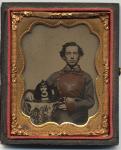
James Jones, Farmington, ca. 1854
Maine Historical Society
In the nineteenth century, individuals often chose to be photographed in the clothing of their trade or profession, enhancing the image by holding the tools of their occupation. Maine occupational portraits are well represented in the Vickery-Shettleworth Collection by daguerreotypes, ambrotypes, and tintypes.
The Reverend Jotham Sewall of Chesterville, Rev. Jones of Farmington (pictured at left) and the Reverend Asa Cummings of Portland each wear their ministerial collar. Captain Purington of Topsham and Captain Blanchard of exhibit the stern bearded features of men experienced in commanding sailing vessels. In contrast is the elegant appearance of Portland artists John Greenleaf Cloudman and Charles Frederick Kimball. The medical profession is represented by a group tintype of six Bowdoin medical students holding instruments and specimens used in their education.

Glazier, ca. 1865
Maine Historical Society
The dual role of architect and builder in nineteenth century Maine is reflected in four images of men holding compasses, folding rules, and framing squares. The building trades are illustrated in pictures of carpenters with planes and saws, masons with bricks in hand, and a glazier holding a window (pictured at right). The furnishings of homes and buildings were crafted by cabinetmakers such as John Stringer of Hallowell (who also made clothes pins) and Benjamin F. Cunningham of Freedom, shown resting his hand on a sample miniature Empire bureau.
Other trades include printing and harness making. Five tintypes of Bangor origin depict river drivers in their work clothes and spiked leather boots. In one of these images, two loggers exhibit the tools of their trade: a peavey, an ax, and a shovel.

Firefighter, Skowhegan, ca. 1860
Maine Historical Society
During the nineteenth century, membership in a local fire company was a matter of pride, resulting in many men having their picture taken in uniform. The Vickery-Shettleworth Collection contains eight such images from Bangor, Bath, Harpswell, Skowhegan, and Vinalhaven.

Man wearing Masonic regalia, ca. 1860
Maine Historical Society
Fraternal orders enjoyed widespread popularity in nineteenth century Maine, and many members were photographed in their lodge regalia. In an ambrotype, a young man wears an elaborately decorated Masonic vestment and apron (pictured at right). The photographer has taken great pains to highlight the details of these garments with gold paint. The Masonic theme is also present in the Corinthian columns of the mat that frames the image. Another young man sat for a Bowdoinham photographer in his fraternal garb of sash, belt, hat, and sword.
The wide variety of women’s hand crafts, such as weaving, quilting, and crocheting, is reflected in the Vickery-Shettlewroth Collection, with a strong image of an elderly woman knitting. The lady’s plain dress and her old rocking chair indicate a rural origin for this tintype.

Tintype of woman knitting, ca. 1870
Maine Historical Society